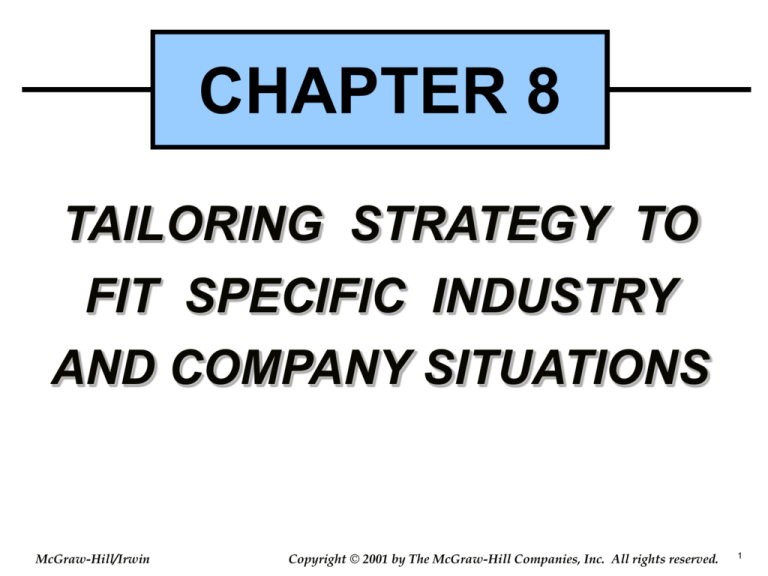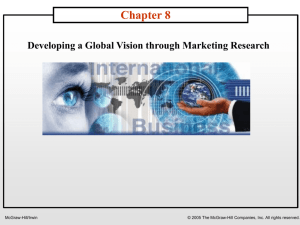
CHAPTER 8
TAILORING STRATEGY TO
FIT SPECIFIC INDUSTRY
AND COMPANY SITUATIONS
McGraw-Hill/Irwin
Copyright © 2001 by The McGraw-Hill Companies, Inc. All rights reserved.
1
“Competing in the marketplace is like
war. You have injuries and casualties,
and the best strategy wins.”
John Collins
“Quote”
McGraw-Hill/Irwin
Copyright © 2001 by The McGraw-Hill Companies, Inc. All rights reserved.
Chapter Outline
Strategies for Emerging Industries
Strategies for Turbulent, High Velocity Markets
Strategies for Maturing Industries
Strategies for Fragmented Industries
Strategies for Sustaining Rapid Growth
Strategies for Weak Businesses
Ten Commandments for Crafting Strategies
McGraw-Hill/Irwin
Copyright © 2001 by The McGraw-Hill Companies, Inc. All rights reserved.
3
Overview: Matching Strategy
to a Company’s Situation
Most important
drivers shaping
a firm’s strategic
options fall into
two categories
McGraw-Hill/Irwin
Nature of industry
and competitive
conditions
Firm’s competitive
capabilities,
market position,
best opportunities
Copyright © 2001 by The McGraw-Hill Companies, Inc. All rights reserved.
4
Features of an Emerging Industry
The capabilities that lead to
True False
competitive advantage are well known.
The necessary technology is easily True
False
available.
Are the entry barriers typically high or low in an
emerging industry?
Buyers are first-time users.
McGraw-Hill/Irwin
True False
Copyright © 2001 by The McGraw-Hill Companies, Inc. All rights reserved.
5
Strategy Options for Competing
in Emerging Industries
What type of marketing initiatives should be
taken to win customers to the industry’s product?
Which value chain activities (both primary and
secondary) are critical?
The product attributes in an
True False
emerging industry are standard.
The industry conditions surrounding True False
an emerging industry require alliances.
McGraw-Hill/Irwin
Copyright © 2001 by The McGraw-Hill Companies, Inc. All rights reserved.
6
Features of High Velocity Markets
Technology changes take
True False
a long time.
Product life-cycles are short .
True False
Competitive moves are
True False
frequent.
Customer expectations do not
True False
change often.
McGraw-Hill/Irwin
Copyright © 2001 by The McGraw-Hill Companies, Inc. All rights reserved.
7
Standard Velocity Industry
Returns
from a
Sustained
Competitive
Advantage
Exploitation
Counterattack
Launch
Time (years)
McGraw-Hill/Irwin
10
Copyright © 2001 by The McGraw-Hill Companies, Inc. All rights reserved.
8
High-Velocity Industry
Returns
from a
Sustained
Competitive
Advantage
Firm continues to
move on to the next
Advantage
Exploitation
Counterattack
Launch
5
McGraw-Hill/Irwin
Time (years) 10
15
Copyright © 2001 by The McGraw-Hill Companies, Inc. All rights reserved.
9
Offensive
Defensive
Figure 8.1: Meeting the Challenge
of High-Velocity Change
Strategic
Posture
Actions
Reacting to
Change
• Introduce better products in
response to new offerings of rivals
• Respond to unexpected changes
in buyer needs and preferences
• Adjust to new government policies
• React and respond as
needed
• Defend and protect
company’s position
Anticipating
Change
• Analyze prospects for market
globalization
• Research buyer needs,
preferences, and expectations
• Monitor new technological
developments to predict future
• Plan ahead for future
changes
• Add/adapt competitive
capabilities
• Improve product line
• Strengthen distribution
• Pioneer new and better
technologies
• Introduce innovative products that
open new markets and spur
creation of whole new industries
• Seek to set industry standards
• Seize the offensive
• Be the agent of industry
change
• Influence rules of the
game
• Force rivals to follow
Leading
Change
McGraw-Hill/Irwin
Strategy
Copyright © 2001 by The McGraw-Hill Companies, Inc. All rights reserved.
10
Strategy Options for Competing
in High Velocity Markets
Invest aggressively in R&D
Develop quick response capabilities
Shift resources, Adapt competencies, Create
new competitive capabilities, Speed new
products to market
Use strategic partnerships to develop specialized
expertise and capabilities
Initiate fresh actions every few months
Keep products/services fresh and exciting
McGraw-Hill/Irwin
Copyright © 2001 by The McGraw-Hill Companies, Inc. All rights reserved.
11
Characteristics of Industry Maturity
What are some of the industry traits of a mature
industry? (recall chapter 3 concepts, e.g., scope
of the rivalry, market growth, etc.)
What activities of the value chain become more
critical?
In mature industries, firms must
True False
look for products to abandon.
McGraw-Hill/Irwin
Copyright © 2001 by The McGraw-Hill Companies, Inc. All rights reserved.
12
Competitive Features of
Fragmented Industries
Fragmented industries have clear
True False
market leaders with high market share.
Buyer demand is homogeneous.
True False
Buyer demand is geographically
True False
scattered.
Scale economies is a major factor.
True False
Buyers buy in large quantities.
True False
What are some possible ways to compete in a
fragmented industry?
McGraw-Hill/Irwin
Copyright © 2001 by The McGraw-Hill Companies, Inc. All rights reserved.
13
Weak Businesses: Strategic Options
What is a turnaround strategy?
What is a liquidation strategy?
What is an end-game strategy?
When should a firm consider a turnaround
strategy? A liquidation strategy? An end-game
strategy?
McGraw-Hill/Irwin
Copyright © 2001 by The McGraw-Hill Companies, Inc. All rights reserved.
14
10 Commandments for Crafting
Successful Business Strategies
1. Always put top priority on crafting and executing
strategic moves that enhance a firm’s
competitive position for the long-term and that
serve to establish it as an industry leader.
2. Be prompt in adapting and responding to
changing market conditions, unmet customer
needs and buyer wishes for something better,
emerging technological alternatives, and new
initiatives of rivals. Responding late or with too
little often puts a firm in the precarious position
of playing catch-up.
McGraw-Hill/Irwin
Copyright © 2001 by The McGraw-Hill Companies, Inc. All rights reserved.
15
10 Commandments for Crafting
Successful Business Strategies
3. Invest in creating a sustainable competitive
advantage, for it is a most dependable
contributor to above-average profitability.
4. Avoid strategies capable of succeeding only
in the best of circumstances.
5. Don’t underestimate the reactions and the
commitment of rival firms.
McGraw-Hill/Irwin
Copyright © 2001 by The McGraw-Hill Companies, Inc. All rights reserved.
16
10 Commandments for Crafting
Successful Business Strategies
6. Consider that attacking competitive
weakness is usually more profitable than
attacking competitive strength.
7. Be judicious in cutting prices without an
established cost advantage.
8. Employ bold strategic moves in pursuing
differentiation strategies so as to open up
very meaningful gaps in quality or service or
advertising or other product attributes.
McGraw-Hill/Irwin
Copyright © 2001 by The McGraw-Hill Companies, Inc. All rights reserved.
17
10 Commandments for Crafting
Successful Business Strategies
9. Endeavor not to get “stuck back in the pack”
with no coherent long-term strategy or
distinctive competitive position, and little
prospect of climbing into the ranks of the
industry leaders.
10. Be aware that aggressive strategic moves to
wrest crucial market share away from rivals
often provoke aggressive retaliation in the form
of a marketing “arms race” and/or price wars.
McGraw-Hill/Irwin
Copyright © 2001 by The McGraw-Hill Companies, Inc. All rights reserved.
18






